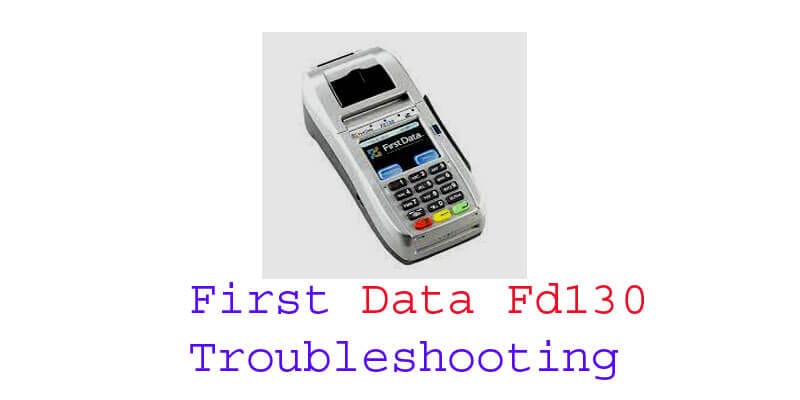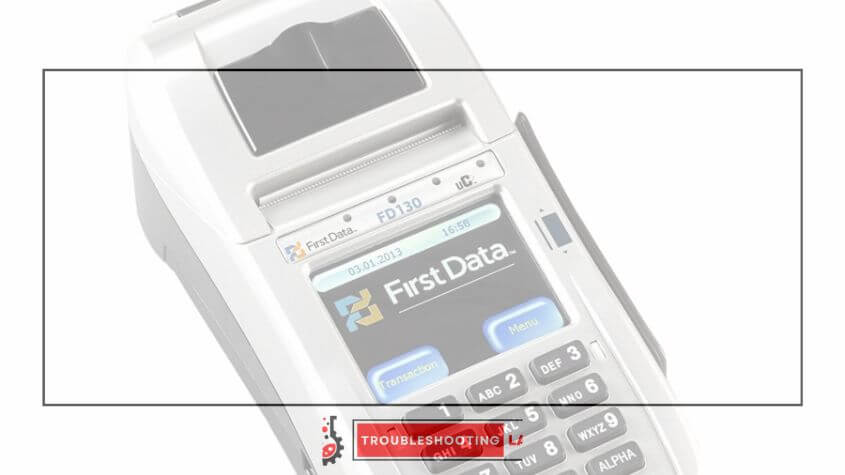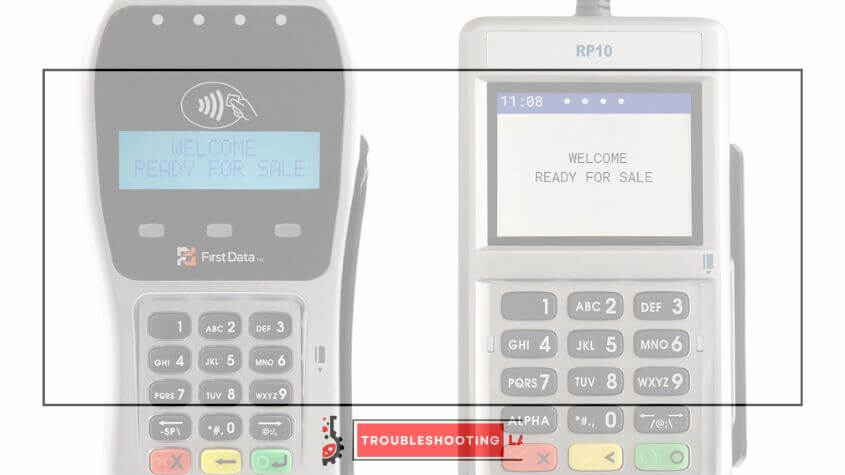The first Data FD130 troubleshooting process helps resolve issues with the payment terminal. Here’s a concise guide to fixing common problems using this device.
The First Data FD130 is a widely used payment terminal that allows businesses to process credit and debit card payments efficiently. However, like any electronic device, it can encounter technical issues from time to time. When faced with such problems, it becomes crucial to have a clear understanding of the troubleshooting process.
By following a systematic approach, you can fix common issues and ensure uninterrupted payment processing. In this article, we will provide an accurate and concise guide to troubleshooting the first data file, FD130, to help you address any concerns and keep your business running smoothly.

Understanding The First Data Fd130 Terminal
The First Data FD130 terminal is a powerful and efficient payment processing device used by businesses worldwide. Whether you are a small retailer or a large corporation, this versatile terminal offers seamless transactions and reliable performance. In this section, we will delve into an overview of the FD130 terminal, explore its features and benefits, and highlight the importance of troubleshooting for optimal performance.
Overview Of The First Data Fd130 Terminal
The FD130 terminal is designed to streamline your payment processing operations and provide a user-friendly experience for both merchants and customers. Here are some key points to help you understand this innovative device:
- Compact design: The FD130 terminal boasts a sleek and compact design, saving valuable counter space without compromising functionality.
- Multiple payment options: With the ability to accept various payment types, including EMV chip cards, contactless cards, and mobile wallet payments such as Apple Pay and Google Pay, this terminal offers flexibility to meet the needs of modern consumers.
- Fast processing speeds: Built with advanced technology, the FD130 terminal ensures speedy transactions, minimizing wait times and enhancing customer satisfaction.
- User-friendly interface: The intuitive interface of the terminal makes it easy for merchants to navigate through different functions, decreasing training time and increasing efficiency.
Features And Benefits Of The Fd130 Terminal
The FD130 terminal is packed with features that simplify payment processing and offer significant benefits to businesses of all sizes. Let’s explore some of its notable features and the advantages they bring:
- Robust security: The FD130 terminal employs advanced encryption technologies and adheres to strict security standards, safeguarding sensitive customer data and protecting your business from potential fraud.
- Integrated printer: With a built-in printer, the FD130 terminal allows for quick and hassle-free receipt printing, eliminating the need for separate devices and reducing clutter on your countertop.
- Reporting and analytics: Gain valuable insights into your business operations with comprehensive reporting features. Track transactions, analyze sales data, and make data-driven decisions for enhanced profitability.
- Compatibility with additional devices: The FD130 terminal seamlessly integrates with other peripheral devices such as cash registers, barcode scanners, and pin pads, providing a comprehensive and interconnected payment solution.
Importance Of Troubleshooting For Optimal Performance
To ensure your FD130 terminal operates at peak performance, troubleshooting is crucial. Regular maintenance and prompt issue resolution can prevent disruptions in your payment processing system. Consider the following points:
- Reducing downtime: Troubleshooting helps identify and address issues swiftly, reducing any potential downtime that may impact your business operations.
- Enhancing customer experience: By promptly resolving any terminal issues, you can maintain a smooth payment experience for your customers, promoting customer satisfaction and loyalty.
- Maximizing efficiency: Efficient troubleshooting methods allow you to identify and resolve recurring issues, optimizing your terminal’s performance and minimizing disruptions in your day-to-day operations.
- Extending terminal lifespan: Proactive troubleshooting and regular maintenance can extend the lifespan of your FD130 terminal, saving you money on expensive repairs or replacements in the long run.
Understanding the features and benefits of the FD130 terminal is essential for maximizing its potential. Additionally, proactive troubleshooting plays a vital role in ensuring optimal performance, reducing downtime, enhancing the customer experience, and prolonging the terminal’s lifespan. By leveraging the capabilities of the FD130 terminal and resolving any issues promptly, you can streamline payment processing and foster success for your business.

Common Issues And Their Solutions
The first data FD130 is a reliable credit card terminal commonly used by businesses. However, like any electronic device, it can encounter some issues. Here are some common issues you may come across while using the first data file, fd130, along with their solutions.
Connectivity Issues And Troubleshooting Steps
Connectivity issues can prevent the FD130 from successfully processing transactions. Here are some troubleshooting steps you can take to resolve connectivity issues:
- Ensure that all cables are securely connected to the appropriate ports on the FD130 and the network router.
- Restart both the FD130 and the network router to refresh the connection.
- Check the network settings on the FD130 to ensure it is properly configured.
- If you are using a wireless connection, make sure the FD130 is within range of the network’s Wi-Fi signal.
- Contact your internet service provider to check for any network issues on their end.
Error Messages And How To Resolve Them
Error messages may appear on the FD130’s screen, indicating an issue with the device. Here are some common error messages you may encounter and how to resolve them:
- “no communication detected”: Check the cable connections between the fd130 and the router, ensuring they are securely plugged in. Restart both devices if necessary.
- “Invalid card”: Verify that the card has been properly inserted into the FD130. Clean the card if necessary, and try again.
- “Authorization declined”: This message indicates that the transaction has been declined by the issuing bank. Ask the customer for an alternative form of payment.
Paper Jams And How To Fix Them
Paper jams can disrupt the printing functionality of the FD130. Follow these steps to fix a paper jam:
- Open the printer compartment by pressing the latch or release button.
- Carefully remove any jammed paper by pulling it in the direction of the paper path.
- Close the printer compartment and ensure it is securely latched.
- Test the printer’s functionality by printing a test receipt.
Power-Related Issues And Troubleshooting Tips
Issues related to the power supply can affect the FD130’s performance. Here are some troubleshooting tips for power-related issues:
- Check that the power cord is securely connected to the FD130 and the power outlet.
- Confirm that the power outlet is functioning properly by plugging in another device.
- If the FD130 is powered by a battery, make sure it is properly charged, or replace it if necessary.
- Contact First Data Support if the issue persists.
Touchscreen Malfunctions And Solutions
When the FD130’s touchscreen malfunctions, it can hinder the device’s usability. Consider these solutions for touchscreen malfunctions:
- Clean the touchscreen using a soft, lint-free cloth to remove any dirt or smudges that may be interfering with touch sensitivity.
- Restart the FD130 to refresh the touchscreen functionality.
- If the touchscreen is unresponsive, contact First Data Support for further assistance.
Remember, taking proactive steps to troubleshoot and resolve the common issues you may encounter with your first data, FD130 will ensure smooth transactions and uninterrupted service.
Advanced Troubleshooting Techniques
Resetting the First Data Fd130 Terminal:
Resetting the first data FD130 terminal can help resolve various issues you may encounter. Here are the key points to keep in mind when performing a reset:
- Locate the reset button on the terminal’s side or bottom.
- Ensure that the terminal is powered off before attempting a reset.
- Use a narrow object, such as a paperclip or pin, to press and hold the reset button for a few seconds.
- Release the button once the terminal’s display turns off, indicating a successful reset.
- Power on the terminal and check if the issues have been resolved.
Accessing the Diagnostic Menu and Its Benefits:
The diagnostic menu of the first data FD130 terminal provides valuable information and can assist in troubleshooting various problems. Here’s what you should know:
- Access the diagnostic menu by powering off the terminal, and then pressing and holding the + and # keys simultaneously.
- The diagnostic menu offers options to run tests on the terminal’s hardware components, such as the printer and keypad.
- It allows you to view device information, including the terminal’s serial number and software version.
- Use the diagnostic menu to identify potential hardware or software issues and gather useful information for troubleshooting purposes.
Upgrading the terminal’s firmware for improved performance:
Regularly updating the firmware of your first Data FD130 terminal can address bugs, enhance security, and improve overall performance. Consider the following points when upgrading the firmware:
- Check for the latest firmware version on the First Data website or consult with your payment processor.
- Download the firmware update file and transfer it to a USB drive.
- Insert the USB drive into the terminal’s USB port.
- From the main menu, select Setup,” followed by “Firmware Upgrade.”
- Choose the USB drive as the source, and follow the prompts to complete the firmware update.
- After the update, the terminal should operate with improved stability, feature enhancements, and potential bug fixes.
Troubleshooting Network Connectivity and Wireless Signal Strength:
Ensuring a stable network connection is crucial for smooth operation with the first data FD130 terminal. Keep these points in mind when troubleshooting network connectivity:
- Verify that the Ethernet cable or wireless connection is securely connected to the terminal.
- Restart the router or modem to resolve any temporary network issues.
- Check if other devices can connect to the same network to determine if the problem is specific to the terminal.
- If using a wireless connection, ensure that the terminal is within range of the wireless network and that the signal strength is sufficient.
- Consider using a Wi-Fi signal booster or repositioning the terminal to improve wireless connectivity.
Resolving Software Issues and Conflicts:
Software issues can occasionally arise with the first data terminal, the FD130. Follow these steps to troubleshoot and resolve common software problems:
- Restart the terminal to clear any temporary glitches or software conflicts.
- Update the terminal’s software to the latest version using the appropriate firmware upgrade process.
- Identify and remove any recently installed applications or modifications that may be causing conflicts.
- Perform a factory reset as a last resort to return the terminal to its default settings and eliminate software-related issues.
Keeping these troubleshooting techniques in mind will help you address a wide range of issues you may encounter with your first Data FD130 terminal, ensuring a smooth and reliable payment processing experience.
Tips And Tricks For Efficient Troubleshooting
Having trouble with your first Data FD130 terminal? Don’t fret! Troubleshooting doesn’t have to be a daunting task. With the right tips and tricks, you can get your terminal up and running smoothly again. In this section, we’ll explore some strategies for efficient troubleshooting that will save you time and frustration.
Regular Maintenance Practices for the FD130 Terminal:
To keep your FD130 terminal in optimal condition and prevent potential issues, make sure to follow these regular maintenance practices:
- Clean the terminal regularly with a soft, lint-free cloth to remove any dirt or debris that might affect its functionality.
- Keep the terminal in a well-ventilated area to prevent overheating.
- Inspect and secure all cables and connections to ensure stable power and data transmission.
- Update your terminal’s software regularly to benefit from the latest bug fixes and improvements.
Using the Terminal’s Self-Diagnostic Features:
The FD130 terminal comes equipped with self-diagnostic features that can help identify and resolve common issues. Here’s how to make the most of them:
- Access the terminal’s diagnostic menu by pressing the “0” and “enter” keys simultaneously.
- Use the diagnostic menu to check for hardware issues, perform tests, and obtain helpful information about your terminal’s configuration.
- Follow the prompts and instructions provided in the diagnostic menu to troubleshoot and resolve specific problems.
Common Shortcuts and Time-Saving Tricks for Troubleshooting:
When faced with troubleshooting tasks, leverage these shortcuts and tricks to save time and streamline your efforts:
- Familiarize yourself with common error codes and their meanings to expedite the identification of issues.
- Restart the terminal before diving into complex troubleshooting steps, as it can sometimes solve minor software glitches.
- Keep a record of frequently encountered problems and their solutions for quick reference.
- Utilize the terminal’s keyboard shortcuts to navigate through menus and perform functions efficiently.
Troubleshooting Tips for Specific Payment Card Processing Issues:
Encountering payment card processing issues can disrupt your business operations. Here are some troubleshooting tips to address common problems:
- If the terminal displays an “invalid card” message, ensure the card is inserted correctly, clean the card’s magnetic strip, or ask the customer to use a different card.
- For slow transaction processing, check your internet connection, relocate the terminal to a spot with better reception, or consider using a wired connection to ensure stable data transfer.
- Should the terminal struggle with reading EVM chip cards, ensure the chip is intact and undamaged, clean the chip reader, or try inserting the card at a different angle.
Utilizing Online Resources and Support for Troubleshooting Help:
When all else fails, don’t hesitate to seek assistance from online resources and support channels. Here are some avenues that can provide valuable troubleshooting help:
- Visit the First Data website’s support section for access to helpful articles, FAQs, and user forums.
- Contact First Data’s customer support via phone or email for personalized assistance from knowledgeable representatives.
- Engage with online communities and forums where fellow FD130 terminal users may share their experiences and troubleshoot issues collectively.
With these tips and tricks in your troubleshooting toolbox, you’ll be equipped to conquer any challenges that come your way with your first Data FD130 terminal. Happy troubleshooting!

Frequently Asked Questions
How Do I Troubleshoot the Fd130 Credit Card Terminal?
To troubleshoot the FD130 credit card terminal, start by checking the power source, and connections, and restarting the device.
Why Is My Fd130 Terminal Not Turning On?
If your fd130 terminal is not turning on, make sure it’s connected to a working power source and the power cable is securely plugged in.
How Can I Fix the “No Line, Check Phone” Error on My Fd130?
To fix the “no line, check phone” error on your FD130, ensure the phone line is connected properly, and contact your service provider if the issue persists.
What Should I Do If My Fd130 Terminal Is Frozen or Unresponsive?
If your fd130 terminal is frozen or unresponsive, try restarting it by unplugging the power cable, waiting for a few seconds, and then plugging it back in.
How Can I Resolve Issues With Printing Receipts On My Fd130?
To resolve issues with printing receipts on your FD130, ensure the paper roll is loaded correctly, and check if the print head is clean.
Conclusion
To sum up, the first Data FD130 troubleshooting guide provides a comprehensive solution to the common issues faced by users of this credit card terminal. By following the step-by-step instructions provided, users can quickly and effectively troubleshoot any issues they encounter, saving time and frustration.
With troubleshooting tips ranging from connectivity issues to printer malfunctions, this guide covers all the bases and ensures a smooth experience for both businesses and customers. Additionally, the guide emphasizes the importance of regular maintenance and updates to keep the FD130 performing optimally.
By addressing common problems and providing practical solutions, this guide empowers users to overcome technical challenges and maintain an efficient and reliable payment processing system. With the help of the FD130 troubleshooting guide, businesses can confidently process transactions and provide seamless service to their customers.
So don’t let technical glitches hinder your business’s success, leverage this comprehensive troubleshooting guide to ensure smooth operations and customer satisfaction.




